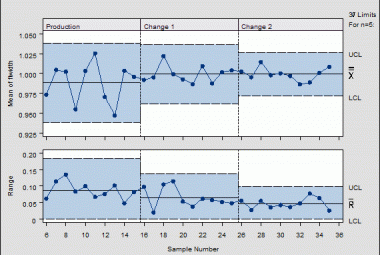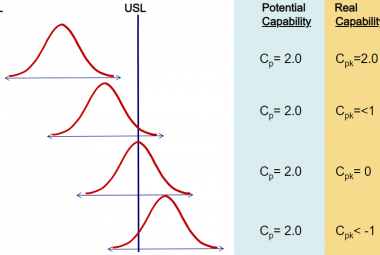The University of Improvement Skills is the fourth building in the Fortress of Change. After targets for improvement have been set and methods for improvement are selected, all employees need to be trained in using the tools correctly. When it comes to continuous improvement: it is the tools which visualize problems, but the people who solve them. Everyone in the organization should be part of the training program, from plant manager to operator, to understand both the advantages of different Lean tools as well as the cultural values that are necessary to be able to create a learning organization.
This article will set out four different levels of training: Multiple day courses (1), Small Workshops (2), Kaizen Events (3) and individual Coaching (4).
MULTIPLE DAY TRAININGS can be used to teach the background of continuous improvement and explain the tools which will be used in your organization in the near future. At the moment of publishing this article we have taught 60% of our population in a two week course, including participants from all ranks, from our manager through operators.
I personally believe that the Ideal (Lean) Training should include at least the following four elements: Theory (1), Simulation Process (2), Factory assignments (3), and Personal/Group reflection (Hensei) (4).
Theory includes the Lean Tools which are used to visualize ´problems´ and facilitate your culture of continuous improvement and Liker´s 14 Toyota Principles which help the people solving the problems. The tools which are taught should already have been defined in the Market of Methods and include both the basic set of tools, 6S, Standard Work, Communication Cells and Kaizen, tools to Map processes like Value Stream Mapping and Process Mapping and the tools which are important for your specific processes, like Kanban, Autonomous Maintenance or Heijunka.
A Simulation Process will help the participants to practice working with the tools. Well-known examples of simulation games are the Lego Game or the Paper Plane game. In our standard Training, the paper plane game is a repeating exercise where the teams practice on themes as One-Piece flow, line balancing, Standard Work and Continuous Improvement, but also learn to practice Lean behaviors such as ´pull the Andon´, ´a Leader is a coach´ and ´visualize problems´. Important in this game is to practice Kaizen properly: do things smarter instead of different.
After the teams have with the tools in a simulation game, it is time to implement it in a real part of the factory. These factory assignments include the exact same tools as were practiced in the simulation game, but a day later. This way, the participants have to put to practice the tools they learned the day before. Learning by repetition.
Daily group- and personal reflection is used to keep focus on the soft cultural aspects of lean as well. Are the team members living the 14 Lean principles? What are personal strengths of your team members and what can you personally learn from them? When team members represent different hierarchical layers of the organization, good discussions will take place covering topics like who and how to lead a team, trusting each other in a team and coaching each other how to be more effective.
SMALL WORKSHOPS can help to bring one single topic to a group´s attention. Experience learns that the best way to learn how to use a tool is by practice. I facilitate different topics in our firm this way, including the basic Lean tools: how to implement 6S, how to implement and document a Kaizen, and how to have an effective Commcell meeting.
HOW TO DESIGN A TRAINING ELEMENT? Based on a Book of a Dutch Trainer Specialist Karin de Galan each Element should include the following seven steps.
- The effect you want to change which people experience at work. This can be done by showing a short video or asking questions to the group.
Example: show a video about how not to do a commcell meeting - An effect is always experienced in a certain situation. Ask the group of they can name a situation where they experience the effect you described in step 1.
Commcell example: ask the group if they recognize what they saw in the video. - Situations are influenced by behavior. What behavior leads to certain situations which lead in turn to this effect we are trying to minimize?
Commcell example: ask the group to list behavior which might lead to the effects we saw in the video, for instance: not having an agenda, no clear KPI´s, not starting on time, people coming late, etc. - Now it is time to present the tool or theory which will help us change the behavior stated in step 3. This is the moment in our example where you as trainer can present the Communication cell.
- Explain how the tool will help the group in changing behavior and therefore certain effects. This is the first and only part of the Training Element where PowerPoint sheets can be used.
- Practice the theory with a question or a small assignment in the group to check if they have understood what the tool is all about.
- Hand out an assignment for the participants or teams to practice what they´ve just learned.
In our Commcell example this could be: build a commcell for your team/department X.
The first three steps are what De Galan describes as ´the slide´, where you make your participants curious about what you are about to share with them, because they have made a connection between the problem you want to solve and their own working environment.
Step four till seven are called ´the stairs´. These steps describe how to prevent the problem or effect from (re)occurring, by evoking different behaviors in a certain situation.
Next to trainings and workshops, a common topic in Lean Literature is to have KAIZEN EVENTS, in which a group of employees fix one particular problem in 1 to 5 full days (Suzaki, 1993; Liker, 2004).
In our plant, we organize one full day each month, in which operators from each shift come together to discuss the next implementation steps of our Lean house for the Shop floor. A Kaizen event is also suitable for solving one big organizational problem in which many functions are concerned. Instead of having a weekly 30 minute meeting for months in a row, the problem is dealt with in a few days.
Lastly the level of INDIVIDUAL COACHING can be defined. Everyone in the organization should be motivated to continuously improve his or her own processes, to implement Kaizen. Just sending people to training is usually not enough to get people acquainted with the new way of working. Having coaches facilitating repetition of the new way of working helps people to internalize the new way of working, so they can reform to them (Deutschman, 2007).
Managers as well as supporting functions should perform Gemba Walks. These are time slots in which you walk the Gemba (place where it happens) without having your own agenda and talk to the people who work there. These are the times to get to know your colleagues, learn about the processes in your team or organization and lead to possibilities for individual coaching. Personally, I have three fixed Gemba Walks planned in my weekly calendar, on Monday, Wednesday and Friday, to make sure I encounter three different teams during the week.
Because bottom-up improvements are the foundation of every Lean initiative, it is important to ask your colleagues about their continuous improvement activities. Five questions which can be asked during a Gemba walk are:
- How are you doing? (people are a company’s most valuable asset)
- How is your process doing today? (learn more about what is happening at this workstation)
- Are you at the moment involved in improvement activities or working on a Kaizen?
- What is holding you back at this workstation in terms of moral or effectiveness? (possible kaizen)
- How can I help you improve this? (encourage own initiative)
Finally, Gemba walks can be used for kamishibai (mini-audits). These audits structuralize the conversation between the visitor and the operator and help finding the next possible improvement.
After the Lean Roadmap is defined for the organization in which is defined what Lean tools are useful in your situation, a trainings plan should be made. Multiple day trainings give you a head start because you can share a lot of new theory with your colleagues. Small workshops can be used to refresh the knowledge of what was learned in the trainings or put the learned theory into praxis. Improvements that require interdisciplinary input are solved in Kaizen Events in which the problem is solved in a few dedicated days. on personal level, individual coaching used to learn about processes, motivate people to practice Kaizen and perform kamishibai checks.
This is article 5 in the series ‘The Fortress of Change‘
Continue to:
The Monastery of reflection and Focused Growth
REFERENCES:
Deutschman, A, 2007, Change or Die, New York: HarperCollins Publishers
Galan de, K., 2008, van Deskundige naar Trainer, Pearson BeneLux
Liker, J.,2004, The Toyota Way – 14 Management Principles From The world’s Greatest Manufacturer, New York: McGraw Hill. (summary)
Rother, M., 2010, Toyota Kata, Managing people for improvement, adaptiveness and superior results, USA: Mc Graw-Hill (summary)
Suzaki, K., 1993; The New Shop Floor Management: Empowering People for Continuous Improvement, New York: Free Press












